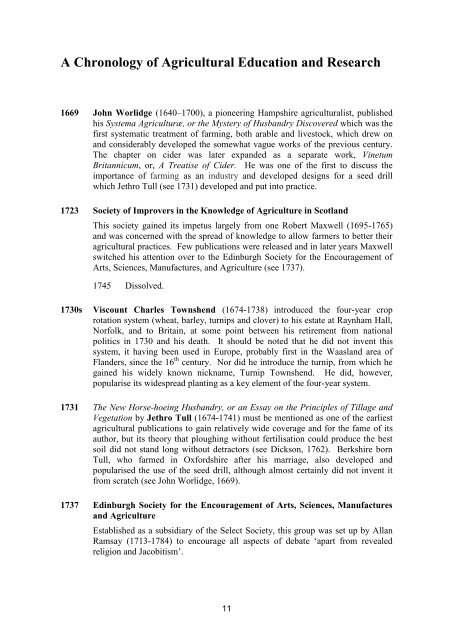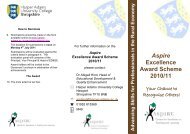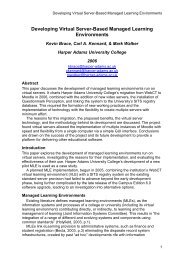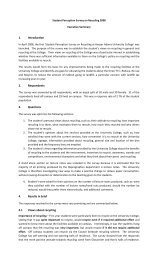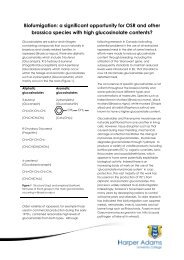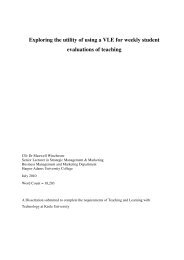a short history of agricultural education and research
a short history of agricultural education and research
a short history of agricultural education and research
You also want an ePaper? Increase the reach of your titles
YUMPU automatically turns print PDFs into web optimized ePapers that Google loves.
A Chronology <strong>of</strong> Agricultural Education <strong>and</strong> Research1669 John Worlidge (1640–1700), a pioneering Hampshire <strong>agricultural</strong>ist, publishedhis Systema Agriculturæ, or the Mystery <strong>of</strong> Husb<strong>and</strong>ry Discovered which was thefirst systematic treatment <strong>of</strong> farming, both arable <strong>and</strong> livestock, which drew on<strong>and</strong> considerably developed the somewhat vague works <strong>of</strong> the previous century.The chapter on cider was later exp<strong>and</strong>ed as a separate work, VinetumBritannicum, or, A Treatise <strong>of</strong> Cider. He was one <strong>of</strong> the first to discuss theimportance <strong>of</strong> farming as an industry <strong>and</strong> developed designs for a seed drillwhich Jethro Tull (see 1731) developed <strong>and</strong> put into practice.1723 Society <strong>of</strong> Improvers in the Knowledge <strong>of</strong> Agriculture in Scotl<strong>and</strong>This society gained its impetus largely from one Robert Maxwell (1695-1765)<strong>and</strong> was concerned with the spread <strong>of</strong> knowledge to allow farmers to better their<strong>agricultural</strong> practices. Few publications were released <strong>and</strong> in later years Maxwellswitched his attention over to the Edinburgh Society for the Encouragement <strong>of</strong>Arts, Sciences, Manufactures, <strong>and</strong> Agriculture (see 1737).1745 Dissolved.1730sViscount Charles Townshend (1674-1738) introduced the four-year croprotation system (wheat, barley, turnips <strong>and</strong> clover) to his estate at Raynham Hall,Norfolk, <strong>and</strong> to Britain, at some point between his retirement from nationalpolitics in 1730 <strong>and</strong> his death. It should be noted that he did not invent thissystem, it having been used in Europe, probably first in the Waasl<strong>and</strong> area <strong>of</strong>Fl<strong>and</strong>ers, since the 16 th century. Nor did he introduce the turnip, from which hegained his widely known nickname, Turnip Townshend. He did, however,popularise its widespread planting as a key element <strong>of</strong> the four-year system.1731 The New Horse-hoeing Husb<strong>and</strong>ry, or an Essay on the Principles <strong>of</strong> Tillage <strong>and</strong>Vegetation by Jethro Tull (1674-1741) must be mentioned as one <strong>of</strong> the earliest<strong>agricultural</strong> publications to gain relatively wide coverage <strong>and</strong> for the fame <strong>of</strong> itsauthor, but its theory that ploughing without fertilisation could produce the bestsoil did not st<strong>and</strong> long without detractors (see Dickson, 1762). Berkshire bornTull, who farmed in Oxfordshire after his marriage, also developed <strong>and</strong>popularised the use <strong>of</strong> the seed drill, although almost certainly did not invent itfrom scratch (see John Worlidge, 1669).1737 Edinburgh Society for the Encouragement <strong>of</strong> Arts, Sciences, Manufactures<strong>and</strong> AgricultureEstablished as a subsidiary <strong>of</strong> the Select Society, this group was set up by AllanRamsay (1713-1784) to encourage all aspects <strong>of</strong> debate ‘apart from revealedreligion <strong>and</strong> Jacobitism’.11


